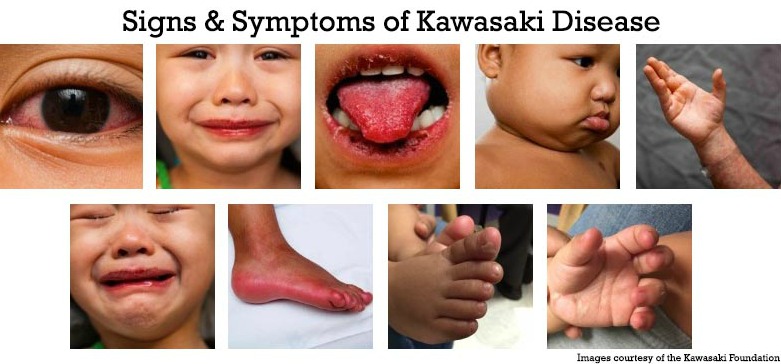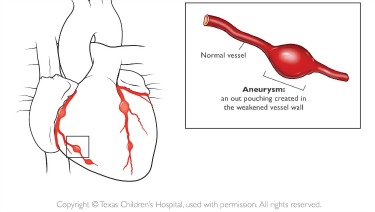Dark Skin in 10 Fingers of 2 Months Baby Is Heart Disease
Kawasaki affliction is the leading cause of acquired center disease in infants and young children in the United States. More than than 4,200 U.S. children are diagnosed with Kawasaki illness each year.
The condition causes inflammation in the blood vessels, and the symptoms can exist astringent. In addition to several days of fever, children with Kawasaki illness may develop symptoms such as rash, swollen neck glands, bloated easily and feet, and cherry optics, lips and natural language.
Early on on, Kawasaki affliction tin affect the function of the middle muscle or the heart valves. If it is recognized and treated early, children tin can begin to feel better in a few days with a depression likelihood of long-term heart issues.
Fast Facts:
- fourscore% to 90% of Kawasaki disease cases occur in children under historic period 5 and older than 6 months. It is less mutual for older children and adolescents to get the illness, but some do.
- Kawasaki affliction is not contagious. It does not spread among family members or children in child care centers.
- Kawasaki disease occurs more frequently in children of Asian or Pacific Island ancestry. Even so, it tin can affect people in all racial and ethnic groups.
- The cause of Kawasaki disease is not known, only it is thought to be a reaction by the body's allowed arrangement.
Signs & Symptoms:
Kawasaki Illness begins with a fever above 102 degrees F that lasts for at to the lowest degree five days. Other signs and symptoms may include:
- Rash anywhere on the body simply more severe in the diaper expanse.
- Red, bittersweet eyes without pus, drainage, or crusting.
- Swelling and tenderness of a gland (lymph node) on ane side of the neck.
- Bloated hands and feet with redness on the palms of the easily and the soles of the feet.
- Very red, swollen, and croaky lips; strawberry-similar tongue with crude, red spots.
- Significant irritability and fussiness.
- Peeling fingers and toes (typically 2 to 3 weeks afterward the beginning of fever).
Notation: The following key signs and symptoms may not be present at the same time. In some very young infants, simply a few of these really develop. Other non-specific symptoms may likewise exist present, such as vomiting, diarrhea, stomachache, cough, runny nose, headache, or pain or swelling of the joints.

When to call the doctor:
If your kid has a fever for 4 to 5 days with any of the key signs and symptoms above, ask your doctor whether he or she could take Kawasaki illness. Information technology tin be challenging to diagnose, so your child may have to be examined several times. See When to Telephone call the Pediatrician: Fever for more than information specific to fevers.
Diagnosis:
There is no specific, single examination to diagnose Kawasaki disease. If Kawasaki disease is suspected, all the same, your doctor may order tests to monitor heart part (an echocardiogram) and may have blood and urine samples. In addition, your doctor may refer y'all to a pediatric specialist in infectious disease, rheumatology or cardiology for more than guidance in diagnosis and handling.
Complications if left untreated:
 If Kawasaki illness is left untreated, it tin lead to serious complications such as inflammation of the claret vessels. This can be particularly dangerous considering it can affect the coronary arteries--the claret vessels that supply blood to the middle muscle--causing coronary artery aneurysms to develop. An aneurysm is a ballooning out of a damaged and weakened claret vessel wall.
If Kawasaki illness is left untreated, it tin lead to serious complications such as inflammation of the claret vessels. This can be particularly dangerous considering it can affect the coronary arteries--the claret vessels that supply blood to the middle muscle--causing coronary artery aneurysms to develop. An aneurysm is a ballooning out of a damaged and weakened claret vessel wall.
Fortunately, handling within the first x days of illness significantly decreases the risk of aneurysms. That's why information technology is very important to diagnose Kawasaki disease by the 10th day of the affliction. Treatment should begin as soon as possible.
Treatment for Kawasaki Disease:
Children diagnosed with Kawasaki disease are admitted to the infirmary. The medication used to treat Kawasaki disease in the hospital is called intravenous gamma globulin (IVIG). IVIG is given through a vein over 8 to 12 hours. Children stay in the hospital for at least 24 hours after completing the IVIG dose to make sure the fever does non return and other symptoms are improving.
Children may too be given aspirin to lower the adventure of eye issues. (Aspirin should but be given to young children under doctors' supervision, as information technology tin cause a serious liver status called Reye Syndrome.)
Boosted treatments may be needed if a child does not answer well to the unmarried dose of IVIG, the fever returns, or at that place are abnormal findings on the first echocardiogram. Another dose of IVIG or other medications that fight inflammation such as steroids, infliximab, or etanercept may be recommended. Pediatric specialists in rheumatology, infectious disease, or cardiology may be consulted in this situation.
What to expect afterwards hospital discharge:
Children treated for Kawasaki Disease are sent home from the hospital on a depression dose of aspirin to take by rima oris every day for 6 to 8 weeks. As they recover, it is not uncommon for these children to be extra tired or seem "off" for several weeks. Rest is very important. Peeling of peel the hands and feet is expected and is not cause for alarm.
Call your doctor right abroad if your child develops a fever or any of the other symptoms of Kawasaki Disease return. Further evaluation will be needed to determine if your child needs to be go back to the hospital.
Follow-up Care:
It is very important to closely monitor children who accept had Kawasaki Disease to brand sure they are improving and to check for the development of coronary aneurysms. Aneurysms most ofttimes form after the first couple of weeks of illness, so children should be scheduled for an echocardiogram and a bank check-up at two weeks and once more at 6 to 8 weeks after their fever first started. More frequent follow up and echocardiograms volition be necessary if there are abnormal findings on whatever of the echocardiograms.
Note: Live viral vaccines should exist postponed at least xi months afterward IVIG, considering IVIG can cause the vaccines to be ineffective. These include the MMR (measles, mumps, rubella) and Varicella (chicken pox) vaccines. Children over 6 months of age should receive the inactivated influenza (flu) vaccine injection.
Long-term follow-upwardly:
Children treated for Kawasaki affliction who practise non develop aneurysms have an excellent long-term outcome. However, information technology is important for them to follow a centre healthy diet and lifestyle. Cholesterol levels should exist checked every v years.
Children who practice have coronary aneurysms should exist nether the care of a pediatric cardiologist as they abound and will require special long-term care and follow-upward.
Additional Information & Resources:
- Fever and Your Baby
- Is it OK to see my pediatrician during COVID-nineteen?
- Kawasaki Affliction (CDC.gov)
- Kawasaki Illness Foundation
The data independent on this Web site should non exist used as a substitute for the medical care and advice of your pediatrician. In that location may be variations in treatment that your pediatrician may recommend based on private facts and circumstances.
Source: https://www.healthychildren.org/English/health-issues/conditions/heart/Pages/Kawasaki-Disease.aspx
Post a Comment for "Dark Skin in 10 Fingers of 2 Months Baby Is Heart Disease"